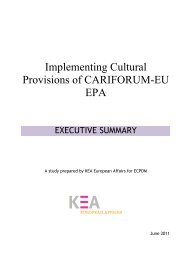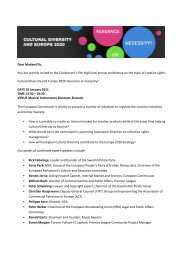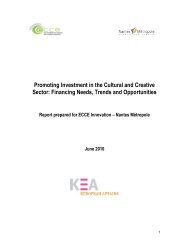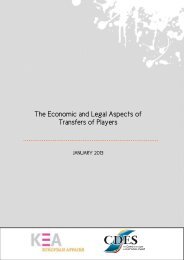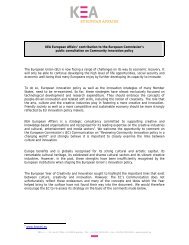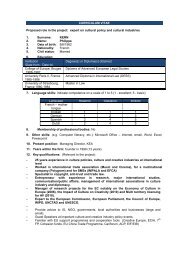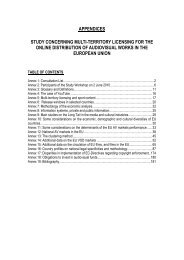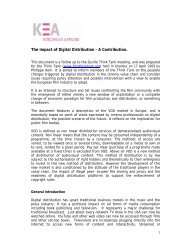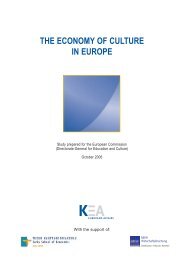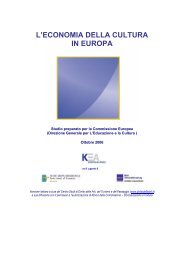Cultural Diversity and EU 2020 - Presentation Philippe Kern at ... - KEA
Cultural Diversity and EU 2020 - Presentation Philippe Kern at ... - KEA
Cultural Diversity and EU 2020 - Presentation Philippe Kern at ... - KEA
You also want an ePaper? Increase the reach of your titles
YUMPU automatically turns print PDFs into web optimized ePapers that Google loves.
<strong>Cultural</strong> <strong>Diversity</strong> <strong>and</strong> <strong>EU</strong> <strong>2020</strong> - <strong>Present<strong>at</strong>ion</strong> <strong>Philippe</strong> <strong>Kern</strong> <strong>at</strong> <strong>EU</strong> Observer Conference<br />
26.01.2011<br />
I have been asked to consider whether cultural diversity is part of the <strong>EU</strong> <strong>2020</strong> project which is to make<br />
a smart, inclusive <strong>and</strong> sustainable Europe.<br />
People want jobs, prosperity – this requires our economy to grow <strong>and</strong> our industries to be more<br />
productive <strong>and</strong> competitive. Can cultural diversity contribute <strong>and</strong> in which ways?<br />
The premises of this present<strong>at</strong>ion are th<strong>at</strong> the European project is the fruit, the result of tensions<br />
between cultures, identities, ideas. This tension <strong>and</strong> differences have led to wars between European<br />
n<strong>at</strong>ions in the past but has also led to the European project. 60 years l<strong>at</strong>er these cultural differences<br />
have made Europe the largest trading bloc in the world <strong>and</strong> the wealthiest. It is the confront<strong>at</strong>ion, the<br />
pluralism of languages <strong>and</strong> cultures th<strong>at</strong> has liber<strong>at</strong>ed thoughts, promoted intellectual exchanges,<br />
scientific <strong>and</strong> artistic development, <strong>and</strong> openness to the world. This diversity should continue to shape<br />
Europe’s destiny <strong>and</strong> sustain the European dream.<br />
Europe is effectively showing to the world th<strong>at</strong> differences are not a cause of conflict but a condition of<br />
progress. The issue of cultural diversity as a cause of Europe’s successes has yet to be examined<br />
seriously. However the ability of Europeans to work together will determine the success of <strong>EU</strong> <strong>2020</strong>. This<br />
ability is also dependent on the way cultural diversity is managed in policy-making.<br />
Today, economic r<strong>at</strong>ionality <strong>and</strong> globaliz<strong>at</strong>ion trends are questioning the traditional visions on culture<br />
policy <strong>and</strong> the way cultural goods or services should be tre<strong>at</strong>ed. At the same time resurgence of<br />
n<strong>at</strong>ionalisms, identity crisis, defiance against Europe on cultural grounds is seriously testing the validity<br />
of the <strong>EU</strong> project (seen by its critics as emblem<strong>at</strong>ic of a bureaucr<strong>at</strong>ic <strong>at</strong>tempt to support uniformity).<br />
As a consequence, the question of the rel<strong>at</strong>ionship between cultural diversity <strong>and</strong> <strong>EU</strong>’s programme for<br />
the next 7 years puts <strong>at</strong> stake:<br />
- the consolid<strong>at</strong>ion of Europe as a political project<br />
Culture is very present on current deb<strong>at</strong>e rel<strong>at</strong>ed to the resurgence of n<strong>at</strong>ionalism which<br />
questions the idea of European integr<strong>at</strong>ion (There is evidence th<strong>at</strong> economic<br />
interdependence does not suffice to cre<strong>at</strong>e a solid union; Belgium is a good example of<br />
disloc<strong>at</strong>ion gener<strong>at</strong>ed by cultural misunderst<strong>and</strong>ing ).<br />
1
- Europe’s innov<strong>at</strong>ion potential <strong>and</strong> the aim of achieving a single market th<strong>at</strong> fosters cre<strong>at</strong>ivity.<br />
Fundamentally the issue of cultural diversity raises the following concrete questions (in rel<strong>at</strong>ion to <strong>EU</strong><br />
<strong>2020</strong> objectives):<br />
1. How do you cre<strong>at</strong>e a “smart, inclusive <strong>and</strong> sustainable Europe” if people do not care about their<br />
neighbours? About their cultures? If dialogue between cultures is not perceived as essential.<br />
2. How can the single market, whether digital or analogue, c<strong>at</strong>er for diversity <strong>and</strong> benefit local<br />
cultural expressions?<br />
3. Should competition policy care about cultural diversity as much as it cares about the impact of<br />
uncompetitive behaviours on consumer prices?<br />
4. Should innov<strong>at</strong>ion be led only by technology <strong>and</strong> science? Are there other forms of innov<strong>at</strong>ion in<br />
which Europe excels th<strong>at</strong> stems from its multiple identities <strong>and</strong> culture <strong>and</strong> which makes this<br />
continent particularly cre<strong>at</strong>ive (in fashion, architecture, design, liter<strong>at</strong>ure, music, games <strong>and</strong><br />
applic<strong>at</strong>ions…)?<br />
The present<strong>at</strong>ion will :<br />
- Review <strong>EU</strong> <strong>2020</strong> <strong>and</strong> the flagship initi<strong>at</strong>ives in light of cultural diversity.<br />
- Consider the single market challenges in light of cultural diversity.<br />
- Examine the contribution of cultural diversity to <strong>EU</strong> <strong>2020</strong>.<br />
<strong>EU</strong> <strong>2020</strong> Str<strong>at</strong>egy – an Architecture without Culture<br />
In March 2010 the European Commission launched the Europe <strong>2020</strong> Str<strong>at</strong>egy to exit the crisis <strong>and</strong><br />
prepare the <strong>EU</strong> economy for the challenges of the next decade. Europe <strong>2020</strong> sets out a vision to achieve<br />
high levels of employment, a low carbon economy, productivity <strong>and</strong> social cohesion, to be implemented<br />
through concrete actions <strong>at</strong> <strong>EU</strong> <strong>and</strong> n<strong>at</strong>ional levels. This is b<strong>at</strong>tle for growth <strong>and</strong> jobs, for Europe’s future<br />
position in the world, the relevance of our continent. The EC sets a series of measurable targets to<br />
achieve its objectives.<br />
Whilst cultural diversity does not qualify as a measurable target <strong>at</strong> least it should be considered as a<br />
means to reaching the inclusiveness <strong>and</strong> sustainability objectives. For instance the <strong>EU</strong> <strong>2020</strong> Str<strong>at</strong>egy<br />
could have st<strong>at</strong>ed as objectives<br />
- to sustain solidarity amongst Europeans,<br />
- to promote the fecund<strong>at</strong>ion potential of cultures as a means of supporting innov<strong>at</strong>ion,<br />
cre<strong>at</strong>ivity, exchange of thoughts, <strong>and</strong> finally<br />
- to fight the steriliz<strong>at</strong>ion of cultures (leading to intolerance, “repli sur soi”).<br />
2
Culture is present in many places in the regul<strong>at</strong>ory <strong>and</strong> EC implement<strong>at</strong>ion pipelines. It is often hidden<br />
under technical <strong>and</strong> bureaucr<strong>at</strong>ic jargon such as digital rights management, open access, etc. Culture<br />
rel<strong>at</strong>es to the following fields:<br />
- Digital single market – which looks into <strong>and</strong> regul<strong>at</strong>es the circul<strong>at</strong>ion of cultural products <strong>and</strong><br />
their protection against theft.<br />
- Competition policy – which questions the role of rights management bodies <strong>and</strong> their cultural<br />
missions.<br />
- St<strong>at</strong>e aid – reviewing <strong>and</strong> vetoing n<strong>at</strong>ional st<strong>at</strong>e aid systems supporting cultural industries.<br />
- Trade rel<strong>at</strong>ions – which review the tre<strong>at</strong>ment of cultural products <strong>and</strong> services in rel<strong>at</strong>ion to<br />
trade liberaliz<strong>at</strong>ion (WTO / Unesco )<br />
Whilst there is no mention of culture in the <strong>EU</strong> <strong>2020</strong> Str<strong>at</strong>egy there is some reference to it in follow up<br />
papers – the so-called flagship initi<strong>at</strong>ives notably.<br />
- Digital Agenda<br />
- Innov<strong>at</strong>ion Union Initi<strong>at</strong>ive <strong>and</strong><br />
- The Regional policy communic<strong>at</strong>ion implementing the <strong>2020</strong> Str<strong>at</strong>egy.<br />
I propose a rapid analysis from a cultural diversity point of view of the Digital Agenda <strong>and</strong> Innov<strong>at</strong>ion<br />
Union initi<strong>at</strong>ives.<br />
The digital agenda is essentially focused on issues regarded as important for the ICT industry. It is<br />
interesting to draw the <strong>at</strong>tention of policy makers to the fact th<strong>at</strong> the size of the cultural sector is<br />
equivalent to the ICT sector in Europe <strong>and</strong> th<strong>at</strong> the l<strong>at</strong>ter is very much dependent on cultural content to<br />
develop its services, whilst the former is heavily dependent on the l<strong>at</strong>ter to protect its intellectual<br />
property. Interdependence has yet to be fully acknowledged in the CIP Programme.<br />
Sector GDP Annual Market<br />
Value<br />
ICT 5% € 660 billion<br />
CULTURE /Cre<strong>at</strong>ive 3% (2003) € 654 billion (2003)<br />
Source: European Commission, <strong>KEA</strong> study on the Economy of Culture in Europe.<br />
Each sector employs approx. 6 million people. There are 1.4 million enterprises in the culture sector<br />
3
The objective of the Digital Agenda has many cultural implic<strong>at</strong>ions as it sets out th<strong>at</strong> “Commercial <strong>and</strong><br />
cultural content <strong>and</strong> services need to flow across borders”. The Digital Agenda is also about preserving<br />
heritage (Europeana) by aggreg<strong>at</strong>ing content <strong>and</strong> “enabling access”. However the promotion of cultural<br />
diversity is not spelt out as an objective of the Digital Agenda.<br />
With cultural diversity as a goal we would expect policy makers to look into ways for new digital services<br />
(wherever their loc<strong>at</strong>ion) to work towards the support of cultural diversity. For instance the CIP<br />
programme, should ensure th<strong>at</strong> new digital services (wherever their loc<strong>at</strong>ion) work to support cultural<br />
diversity with the view of promoting market access to local content in a variety of languages. The<br />
Competitiveness <strong>and</strong> Innov<strong>at</strong>ion Framework Programme (CIP) (http://ec.europa.eu/cip/index_en.htm) is<br />
one of the key funding instruments in support of competitiveness.<br />
The Innov<strong>at</strong>ion Union initi<strong>at</strong>ive of October 2010 also makes reference to culture <strong>and</strong> culture-based<br />
cre<strong>at</strong>ivity by st<strong>at</strong>ing:<br />
“Our strengths in design <strong>and</strong> cre<strong>at</strong>ivity must be better exploited”.<br />
“We must pursue a broad concept of innov<strong>at</strong>ion, both research-driven innov<strong>at</strong>ion <strong>and</strong> innov<strong>at</strong>ion<br />
in business models, design, br<strong>and</strong>ing <strong>and</strong> services th<strong>at</strong> add value for users <strong>and</strong> where<br />
Europe has unique talents”.<br />
“The cre<strong>at</strong>ivity <strong>and</strong> diversity of our people <strong>and</strong> the strength of European cre<strong>at</strong>ive industries, offer huge<br />
potential for new growth <strong>and</strong> jobs through innov<strong>at</strong>ion, especially for SMEs”.<br />
This shift in thinking on innov<strong>at</strong>ion, which takes into consider<strong>at</strong>ion non-technological innov<strong>at</strong>ion, is<br />
welcomed. It is often non-technological innov<strong>at</strong>ion th<strong>at</strong> makes the differences in the market place<br />
(br<strong>and</strong>ing, design, applic<strong>at</strong>ions, entertainment, culture services). This form of innov<strong>at</strong>ion is analyzed in<br />
the <strong>KEA</strong> study “The impact of Culture on Cre<strong>at</strong>ivity “for the European Commission (2010) (available on<br />
www.keanet.eu) .<br />
The CIP programme should better integr<strong>at</strong>e non-technological innov<strong>at</strong>ion in its support mechanisms <strong>and</strong><br />
should consider the spill over effects of cre<strong>at</strong>ivity in cultural industries notably in innov<strong>at</strong>ion within the<br />
ICT sector. The importance of br<strong>and</strong>ing as a condition for market success should be subject to studies, in<br />
particular in the context of the single market.<br />
The European Commission (DG Enterprise) initi<strong>at</strong>ive to establish a European Cre<strong>at</strong>ive Industries Alliance<br />
– ECIA) to develop new forms of support for cre<strong>at</strong>ive SMEs <strong>and</strong> to promote the wider use of cre<strong>at</strong>ivity<br />
by other sectors is to be welcomed <strong>and</strong> supported in the context of CIP .<br />
In summary:<br />
- <strong>Cultural</strong> diversity is <strong>at</strong> the heart of Europe’s economic success, cultural dialogue contributes to<br />
inclusiveness (social cohesion) <strong>and</strong> cre<strong>at</strong>ive industries contribute to innov<strong>at</strong>ion.<br />
- Culture, often considered in a restricted sense as “entertainment”or “content”, is instrumental in<br />
achieving other goals: open access, dissemin<strong>at</strong>ion across frontier, innov<strong>at</strong>ion.<br />
4
- There is some progress in the apprehension of innov<strong>at</strong>ion. However the l<strong>at</strong>ter is still focused on ICT<br />
<strong>and</strong> R&D whilst service innov<strong>at</strong>ion is led by experience, emotion, values, cre<strong>at</strong>ivity in design, br<strong>and</strong>s,<br />
<strong>and</strong> aesthetic. This modern conception of innov<strong>at</strong>ion should transl<strong>at</strong>e in more balanced visions of<br />
financial means to support non-technological innov<strong>at</strong>ion <strong>and</strong> investment in culture <strong>and</strong> cre<strong>at</strong>ive<br />
industries. The European Investment Bank <strong>and</strong> the European Investment Fund should support<br />
investment in cre<strong>at</strong>ive <strong>and</strong> cultural industries.<br />
Innov<strong>at</strong>ion:<br />
<strong>EU</strong> support to Cre<strong>at</strong>ivity <strong>and</strong> Innov<strong>at</strong>ion<br />
2007-2013 (in € billion):<br />
FP7: 53<br />
CIP: 3.6<br />
Structural Funds: 87<br />
Total: 153.6<br />
Structural Funds: € 347 billion<br />
Culture based Cre<strong>at</strong>ivity:<br />
CULTURE: 0.4<br />
MEDIA: 0.7<br />
Structural Funds: 6<br />
Total : less than 7.1<br />
At the heart of the cultural diversity objective lies the single market goal. How to reconcile the single<br />
market with this objective? The single market has done little to develop cultural affinity amongst<br />
Europeans, this is a bottleneck preventing the emergence of solidarity amongst Europeans. There is<br />
essentially considerable indifference to neighbourhood cultures. After 60 years of <strong>EU</strong> integr<strong>at</strong>ion this is a<br />
failure. Can the single market address this (improve the circul<strong>at</strong>ion of local cultural expressions) <strong>and</strong><br />
under which conditions?<br />
A single market for “world culture” or a single market for cultural diversity<br />
Wh<strong>at</strong> is world culture? World culture is the expression to characterize the culture of the best sellers,<br />
the mainstream. Products identified by entertainment companies whether in publishing, music, cinema<br />
as the most likely to travel across frontiers <strong>and</strong> become world hits.<br />
These products have benefited from the single market more than any others (notably Hollywood films,<br />
or rock/pop music).<br />
Why is this? They are selected by marketing experts (usually loc<strong>at</strong>ed in the US) for their intern<strong>at</strong>ional<br />
potential <strong>and</strong> appeal <strong>and</strong> will be subject to intense marketing campaigns throughout the world or main<br />
commercial territories. The products are usually English language productions. As a result Europe is a<br />
5
net importer of content <strong>and</strong> a large number of European countries are adopting measures to protect<br />
their local cultural industries (in particular audiovisual).<br />
Intern<strong>at</strong>ionally the market share of European content (music or film) is less than 5% in the USA (it is the<br />
European continent th<strong>at</strong> invented cinema, fiction in liter<strong>at</strong>ure <strong>and</strong> classical music). Less than 3% of<br />
books published in the US are transl<strong>at</strong>ions from non English language. European n<strong>at</strong>ional content<br />
hardly circul<strong>at</strong>es in Europe. Despite the existence of the Media funding programme over the last 20<br />
years, the market share of non-n<strong>at</strong>ional European films is less than 8%.<br />
It can be concluded th<strong>at</strong> despite Europe, Europeans do not seem interested in the cultural content of<br />
their neighbours or (more likely) th<strong>at</strong> nothing much is being done to stimul<strong>at</strong>e a market dem<strong>and</strong> for<br />
those products. Globalis<strong>at</strong>ion is acceler<strong>at</strong>ing this trend <strong>and</strong> the long tail has not yet occurred to the<br />
extent th<strong>at</strong> we can hope for more non-mainstream content on the Internet. The content industry<br />
remains hit driven.<br />
One may argue th<strong>at</strong> cultural indifference is leading a founding member of the <strong>EU</strong> to the verge of<br />
breaking up (Belgium).<br />
European cultural industries are often marginalized on the world stage because of market <strong>and</strong> linguistic<br />
fragment<strong>at</strong>ion. The priority for European industry is to cre<strong>at</strong>e scale in order to be able to fund<br />
intern<strong>at</strong>ional productions with intern<strong>at</strong>ional potential or worldwide marketing campaigns. Scale is also<br />
required to negoti<strong>at</strong>e better deals with distribution pl<strong>at</strong>forms th<strong>at</strong> oper<strong>at</strong>e intern<strong>at</strong>ionally, in particular<br />
for SMEs. The single market objective should be used as a tool for achieving scale. However there are<br />
two opposing visions on the single market:<br />
- A vision where Europe is simply a market for world culture.<br />
- Or where Europe is a distinctive space nurturing diversity of expressions.<br />
The reconcili<strong>at</strong>ion of single market objectives with cultural diversity remains an important challenge.<br />
It should be added th<strong>at</strong> culture benefits from a regime of regul<strong>at</strong>ory exceptions:<br />
o Copyright is protected from the full applic<strong>at</strong>ion of the principle of free movement of<br />
goods.<br />
o In competition policy ( St<strong>at</strong>e Aid is justified for cultural reasons – art 107(d))<br />
o Some cultural products <strong>and</strong> services benefit from a specific VAT regime (VAT directive)<br />
o St<strong>at</strong>e support to cultural industries is shielded from intern<strong>at</strong>ional trade law following the<br />
adoption of the UNESCO Convention on <strong>Cultural</strong> <strong>Diversity</strong>.<br />
o AV quotas may limit the free flow of AV programmes on networks (AV Media services<br />
Directive).<br />
In a recent study for DG INFSO on multi-territory licensing <strong>and</strong> VOD we have highlighted <strong>at</strong>tempts by the<br />
<strong>EU</strong> regul<strong>at</strong>or to mitig<strong>at</strong>e the impact of this derog<strong>at</strong>ory regime. Culture is often perceived as disruptive to<br />
the single market <strong>and</strong> competition principles. Examples of <strong>at</strong>tempts to curtail this regime of exceptions<br />
are:<br />
- Country of origin principle.<br />
- M<strong>and</strong><strong>at</strong>ory collective licensing (cable retransmission) to facilit<strong>at</strong>e licensing<br />
6
- Principle of exhaustion – to prevent abusive partitioning of the market through territorial exclusivity.<br />
The issue of the single market is often blurred by the idea th<strong>at</strong> availability is sufficient to cre<strong>at</strong>e a<br />
dem<strong>and</strong> for European content. The Digital Agenda remains focused on opening up access to content<br />
providers. It st<strong>at</strong>es: “Consumers expect, rightly, th<strong>at</strong> they can access content online <strong>at</strong> least as<br />
effectively as in the offline world” or “Europe lacks a unified market in the content sector.”<br />
The Digital Agenda rightly identifies licensing of IP rights as a major issue. However its premises are too<br />
narrow as its assessment remains focused on the aspects of ICT take up <strong>and</strong> consumer access when it<br />
st<strong>at</strong>es for instance: “Consumers can buy CDs in every shop but are often unable to buy music from<br />
online pl<strong>at</strong>forms across the <strong>EU</strong> because rights are licensed on a n<strong>at</strong>ional basis. This contrasts with the<br />
rel<strong>at</strong>ively simple business environment <strong>and</strong> distribution channels in other regions, notably the US, <strong>and</strong><br />
reflects other fragmented markets such as those in Asia.<br />
DG INFSO is right to st<strong>at</strong>e th<strong>at</strong> it is imper<strong>at</strong>ive to simplify copyright clearance <strong>and</strong> the management of<br />
cross-border licensing. However it is too partial when it puts the focus only on promotion of ICT take up<br />
or consumer access. The lack of harmoniz<strong>at</strong>ion in copyright protection needs to be reflected upon as<br />
well as the supply issue (diversity, investment in local production, marketing expenses to cre<strong>at</strong>e a<br />
dem<strong>and</strong>).<br />
The comparison with the US market remains unfortun<strong>at</strong>e as the USA Is essentially a one/two languages<br />
market. It cannot be compared with a market composed of a p<strong>at</strong>chwork of cultures from 27 different<br />
Member St<strong>at</strong>es. The single market has to acknowledge this major difference <strong>and</strong> propose regul<strong>at</strong>ion<br />
th<strong>at</strong> takes care of this “constraint”.<br />
The EC decisions in the CISAC case or in the recommend<strong>at</strong>ion of 2006 on music licensing have been<br />
adopted in the absence of impact assessment on the cultural consequences of narrow approaches.<br />
These are instances where the regul<strong>at</strong>or’s intervention has made things worse for the oper<strong>at</strong>ors<br />
whether they are users or right holders.<br />
Therefore it remains to be seen how cultural diversity can contribute to <strong>EU</strong> <strong>2020</strong> in the context of<br />
policies pursued to establish the internal market <strong>and</strong> the Digital Agenda. Foremost there is a need to<br />
recognize <strong>and</strong> apprehend the specificity of cultural industries <strong>and</strong> institutions with a view to honour<br />
art3.3 of the <strong>EU</strong> Tre<strong>at</strong>y 1 :<br />
- Market segment<strong>at</strong>ion enables to maximize returns on investment in particular in capital intensive<br />
industries such as cinema/performance rights (acknowledged by the ECJ).<br />
- Linguistic fragment<strong>at</strong>ion makes distribution more difficult <strong>and</strong> therefore limits consumer access.<br />
- Industrial structure, essentially locally based SMEs (no intern<strong>at</strong>ional <strong>and</strong> marketing muscles) lack the<br />
scale to benefit from the single market.<br />
1 The Union shall establish an internal market. ….. It shall respect its rich cultural <strong>and</strong> linguistic diversity, <strong>and</strong> shall<br />
ensure th<strong>at</strong> Europe's cultural heritage is safeguarded <strong>and</strong> enhanced.<br />
7
The contribution of cultural diversity to <strong>EU</strong> <strong>2020</strong><br />
Why should Belgium be a country? People in Fl<strong>and</strong>ers or in Wallonia are now asking themselves..<br />
Similarly citizens throughout Europe are questioning: why Europe?<br />
Another committee of wise men will tell us th<strong>at</strong> without Europe we st<strong>and</strong> little chance against the USA<br />
or emerging economies. Is this the only justific<strong>at</strong>ion? Europe finds its justific<strong>at</strong>ion <strong>at</strong> another level: in<br />
the establishment (architecture) of a common desire, shared values <strong>and</strong> identity, a common will.<br />
How do you go about establishing this common will? Today the solidarity uniting European people is<br />
essentially based on economic <strong>and</strong> security interests. In the meantime, the mood is changing, people<br />
are claiming more autonomy – in Fl<strong>and</strong>ers, C<strong>at</strong>alonia, Scotl<strong>and</strong> for instance. And Europe needs to listen<br />
to these people in need of identity <strong>and</strong> who are not necessarily anti-Europeans or fervent n<strong>at</strong>ionalists.<br />
The European project will be able to move forward thanks to its ability to provide sufficient space for the<br />
expression of diversity for people to be able to feel comfortable in the Union.<br />
The founding f<strong>at</strong>hers built Europe through the market. They used steel <strong>and</strong> coal as a means to foster<br />
solidarity. Where would the founding f<strong>at</strong>hers start to cement cooper<strong>at</strong>ion <strong>and</strong> solidarity amongst<br />
European n<strong>at</strong>ions if they were to establish the <strong>EU</strong> today? With culture <strong>and</strong> ICT? Why culture?<br />
Products are increasingly customized, individualized (requiring differenti<strong>at</strong>ion). The new economy is an<br />
economy of experience (as described by economists Pine <strong>and</strong> Gilmour / Scott Lash <strong>and</strong> John Urry /<br />
J.Rifkin, O.Bomsel). It is an economy of the imm<strong>at</strong>erial where values <strong>and</strong> signs are as important as the<br />
functionality of a product. The cultural value of a product becomes as important as its economic value.<br />
Culture-based cre<strong>at</strong>ivity is an essential fe<strong>at</strong>ure of a post-industrial economy. A firm needs more than an<br />
efficient manufacturing process, cost-control <strong>and</strong> a good technological base to remain competitive. It<br />
also requires a strong br<strong>and</strong>, motiv<strong>at</strong>ed staff <strong>and</strong> a management th<strong>at</strong> respects cre<strong>at</strong>ivity <strong>and</strong><br />
underst<strong>and</strong>s its process. It also needs the development of products <strong>and</strong> services th<strong>at</strong> meet citizens’<br />
expect<strong>at</strong>ions or th<strong>at</strong> cre<strong>at</strong>e this expect<strong>at</strong>ion.<br />
Digital technologies play an important role in this intangible economy as they provide new forms of<br />
social exchanges <strong>and</strong> contribute significantly to new expressions of cre<strong>at</strong>ivity. Of course cultural<br />
production (such as music, publishing <strong>and</strong> movies) makes new technology more relevant to consumers,<br />
enables the development of new markets <strong>and</strong> contributes to digital literacy. However the successes of<br />
free <strong>and</strong> open-source software <strong>and</strong> services like Wikipedia are also trends th<strong>at</strong> prefigure an economy in<br />
which sharing <strong>and</strong> exchanging knowledge <strong>and</strong> skills are not principally based on securing financial gain.<br />
These new forms of exchanges give more importance to social ends <strong>and</strong> therefore culture-based<br />
cre<strong>at</strong>ivity. Art <strong>and</strong> culture (in particular music) is often the basis on which social networking takes place<br />
(peer-to-peer file sharing).<br />
For industry it therefore becomes an imper<strong>at</strong>ive to meet <strong>and</strong> to cre<strong>at</strong>e new kinds of dem<strong>and</strong> th<strong>at</strong> are<br />
not based merely on the functionality of a product but are instead rooted in individual <strong>and</strong> collective<br />
aspir<strong>at</strong>ion. In this new paradigm, marketing <strong>and</strong> services are as important as production. This requires<br />
8
cre<strong>at</strong>ive skills <strong>and</strong> thoughts as productivity gains <strong>at</strong> manufacturing level are no longer sufficient to<br />
establish a competitive advantage. Culture-based cre<strong>at</strong>ivity is a powerful means of overturning norms<br />
<strong>and</strong> conventions with a view to st<strong>and</strong>ing out amid intense economic competition. Cre<strong>at</strong>ive people <strong>and</strong><br />
artists are key because they develop the ideas, metaphors <strong>and</strong> messages which help to drive social<br />
networking <strong>and</strong> experiences.<br />
The founding f<strong>at</strong>hers would recognize th<strong>at</strong> innov<strong>at</strong>ion is a process of interactions <strong>and</strong> spill over between<br />
different processes.<br />
Cre<strong>at</strong>ivity – Multi-dimensional<br />
Cre<strong>at</strong>ivity” is defined as a cross-sector <strong>and</strong> multidisciplinary way,<br />
mixing elements of “artistic cre<strong>at</strong>ivity”, “economic innov<strong>at</strong>ion” as well<br />
as “technological innov<strong>at</strong>ion.”<br />
Scientific cre<strong>at</strong>ivity<br />
Technological<br />
cre<strong>at</strong>ivity<br />
Economic cre<strong>at</strong>ivity <strong>Cultural</strong> cre<strong>at</strong>ivity<br />
A process of interactions <strong>and</strong> spill-over effects between<br />
different innov<strong>at</strong>ive processes<br />
The founding f<strong>at</strong>hers would look into wh<strong>at</strong> makes Europe so distinct: 100’s of languages, 27<br />
n<strong>at</strong>ionalities, 100’s of different cultures – the capacity to be singular. This singularity <strong>and</strong> difference is a<br />
precious economic <strong>and</strong> social resource in a world where the industry is looking to differenti<strong>at</strong>e its<br />
product to gain a competitive edge.<br />
9
Culture plays an important role in today’s economy th<strong>at</strong> requires non-technological innov<strong>at</strong>ion. The<br />
cultural economy is the economy of cre<strong>at</strong>ive industries which fashion the trade <strong>and</strong> commercial universe<br />
<strong>and</strong> which enables companies to st<strong>and</strong> out whether through br<strong>and</strong>ing, design, cre<strong>at</strong>ive content or user<br />
interface. The economy is about cre<strong>at</strong>ing the unexpected, the emotional. Cre<strong>at</strong>ivity is the main driver<br />
of the new economy.<br />
There is still little underst<strong>and</strong>ing on the importance of culture in <strong>EU</strong>’s competitiveness as an economic<br />
sector or as a resource to make products <strong>and</strong> services more competitive.<br />
Conclusion<br />
Europe will never be built according to the model of the United St<strong>at</strong>es – United St<strong>at</strong>es of Europe ;<br />
because n<strong>at</strong>ional <strong>and</strong> regional singularities will persist. A European will remain proud of his local roots,<br />
his country, local language <strong>and</strong> culture. The p<strong>at</strong>chwork of cultures is the fabric of Europe, the source of<br />
its successes. Policy makers have to accept this complexity of Europe, not as a f<strong>at</strong>al destiny but as an<br />
opportunity because this complexity (which has a cost) nourishes cre<strong>at</strong>ivity <strong>and</strong> innov<strong>at</strong>ion. Pluralism<br />
<strong>and</strong> openness to influences are distinct fe<strong>at</strong>ures of the European model. This cosmopolitanism is an<br />
extraordinary resource of cre<strong>at</strong>ivity.<br />
Without underst<strong>and</strong>ing the value of culture in cre<strong>at</strong>ivity, firstly Europe cannot develop a coherent<br />
innov<strong>at</strong>ion str<strong>at</strong>egy; secondly it cannot even begin to challenge the premises of current policy thinking.<br />
Europe needs also to focus on non-technological innov<strong>at</strong>ion in general <strong>and</strong> culture-based cre<strong>at</strong>ivity in<br />
particular. The proposal is to cre<strong>at</strong>e a Europe th<strong>at</strong> stimul<strong>at</strong>es <strong>and</strong> encourages cre<strong>at</strong>ivity <strong>and</strong> provides<br />
individuals, society, public institutions <strong>and</strong> enterprises with incentives to build on culture for social <strong>and</strong><br />
economic renewal.<br />
Sempé<br />
10
The additional challenge for Europe is to make the best of its cultural diversity in the context of<br />
globalis<strong>at</strong>ion. To a large extent, Europe’s future is dependent on its ability to transcend local identities<br />
to harness cre<strong>at</strong>ivity but also to ensure the presence of diverse local identities in an intern<strong>at</strong>ional<br />
context. Europe should remain a central place in the meeting of influences <strong>and</strong> ideas. At the confluence<br />
Europe increases its cre<strong>at</strong>ivity <strong>and</strong> innov<strong>at</strong>ion potential.<br />
The diversity of cultures should be cherished as much as bio diversity. In this respect we should inspired<br />
by the provisions of the Tre<strong>at</strong>y on the environment (Art 191) which sets clear objectives <strong>and</strong> methods<br />
(principle of precaution) to preserve environmental resources.<br />
How will cultural diversity contribute to <strong>EU</strong> <strong>2020</strong>? This depends to a large extent on the way art 167 is<br />
implemented.<br />
Article 167 of the <strong>EU</strong> Tre<strong>at</strong>y provides:<br />
“ The Union shall contribute to the flowering of the cultures of the Member St<strong>at</strong>es, while<br />
respecting their n<strong>at</strong>ional <strong>and</strong> regional diversity <strong>and</strong> <strong>at</strong> the same time bringing the common<br />
cultural heritage to the fore. ……<br />
….The Union shall take cultural aspects into account in its action under other provisions of the<br />
Tre<strong>at</strong>ies, in particular in order to respect <strong>and</strong> to promote the diversity of its cultures. “...<br />
Are we prepared to:<br />
1. balance “economic r<strong>at</strong>ionality” with “economic vision”? Short term efficiency goals may lead to<br />
long term disaster in term of sustainability <strong>and</strong> inclusiveness,<br />
2. accept th<strong>at</strong> the market, whilst having the capacity to produce wealth, can also destroy valuable<br />
cultural resources, thre<strong>at</strong>ening the social fabric, the capacity of culture to cre<strong>at</strong>e social links <strong>and</strong><br />
solidarity? The economic success of Europe will depend on its capacity to work together, to<br />
cooper<strong>at</strong>e, to cre<strong>at</strong>e solidarities,<br />
3. recognise the cultural challenge Europe is faced with due to globalis<strong>at</strong>ion <strong>and</strong> the digital shift?<br />
The <strong>EU</strong> is no longer about the circul<strong>at</strong>ion of “works” as if works were mere products; it is about<br />
the circul<strong>at</strong>ion of « diversity » <strong>and</strong> singular expressions represent<strong>at</strong>ive of <strong>EU</strong>’s diversity <strong>and</strong><br />
factor of cre<strong>at</strong>ivity.<br />
The effects of such acknowledgment enable:<br />
1. to strengthen solidarity – or inclusiveness, with a common ambition based on shared values<br />
(avoid the Belgium or the German/Greek syndrome). A solidarity based only on economic<br />
interest is not the most solid cement.<br />
2. culture to be recognized like research <strong>and</strong> science as an essential tool to make our society<br />
innov<strong>at</strong>ive, sustainable <strong>and</strong> more “competitive”. US President Obama rightly st<strong>at</strong>ed in his<br />
11
St<strong>at</strong>e of the Union address th<strong>at</strong> the main source of power in the 21 st century is cre<strong>at</strong>ive<br />
imagin<strong>at</strong>ion.<br />
These are my proposals for the integr<strong>at</strong>ion of cultural diversity in <strong>EU</strong> <strong>2020</strong>:<br />
1. Regul<strong>at</strong>ory proposals should include an impact assessment on culture <strong>and</strong> diversity. The<br />
principle of precaution should be applied as for environment policy.<br />
2. The cultural agenda needs to apprehend the impact of internal market <strong>and</strong> competition<br />
regul<strong>at</strong>ion on cultural industries <strong>and</strong> institutions.<br />
3. <strong>EU</strong> policies on innov<strong>at</strong>ion need to recognise the cross-sectoral <strong>and</strong> multi-disciplinary aspects of<br />
“cre<strong>at</strong>ivity” which mixes elements of “artistic cre<strong>at</strong>ivity”, “economic” as well as “technological<br />
innov<strong>at</strong>ion”<br />
4. <strong>EU</strong> should establish a cre<strong>at</strong>ivity index or complement the innov<strong>at</strong>ion scoreboard with cre<strong>at</strong>ivity<br />
indic<strong>at</strong>ors. (see <strong>KEA</strong> suggestion in this respect in the study “The Impact of Culture on<br />
Cre<strong>at</strong>ivity”).<br />
5. Research <strong>and</strong> Development, structural funds should be more accessible to cre<strong>at</strong>ive industries to<br />
implement linkages between cre<strong>at</strong>ivity <strong>and</strong> innov<strong>at</strong>ion.<br />
6. CIP to fund studies on the importance of br<strong>and</strong>s, cre<strong>at</strong>ivity <strong>and</strong> the imm<strong>at</strong>erial in innov<strong>at</strong>ion<br />
str<strong>at</strong>egies <strong>and</strong> competitiveness.<br />
7. Support investment in culture (m<strong>and</strong><strong>at</strong>e EIF <strong>and</strong> EIF)<br />
8. Support our industries to cre<strong>at</strong>e scale (acting collectively so th<strong>at</strong> they can influence market<br />
development – 25% market share) <strong>and</strong> make rights licensing less costly. This is oper<strong>at</strong>ors’<br />
responsibility too.<br />
9. Market <strong>and</strong> promote n<strong>at</strong>ional cultural (popular) flagships across frontiers to cre<strong>at</strong>e emp<strong>at</strong>hy <strong>and</strong><br />
dem<strong>and</strong> for other n<strong>at</strong>ional or regional cultures. Celebr<strong>at</strong>e <strong>and</strong> br<strong>and</strong> a Cre<strong>at</strong>ive Europe.<br />
10. Celebr<strong>at</strong>e sub-titling over dubbing to stimul<strong>at</strong>e language learning <strong>and</strong> curiosity.<br />
www.keanet.eu<br />
www.keablog.com<br />
12



